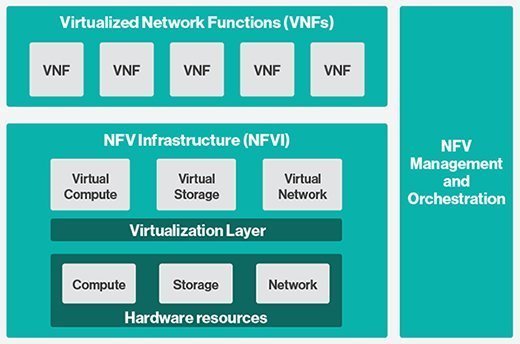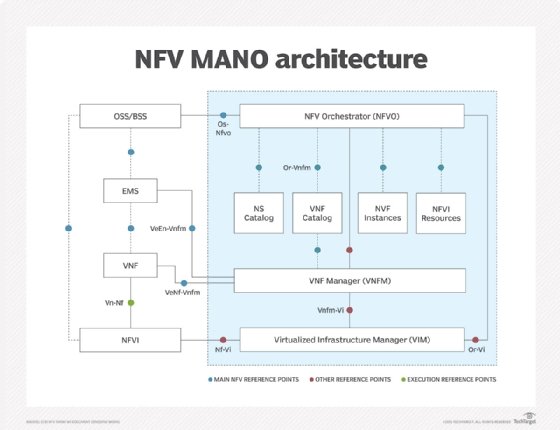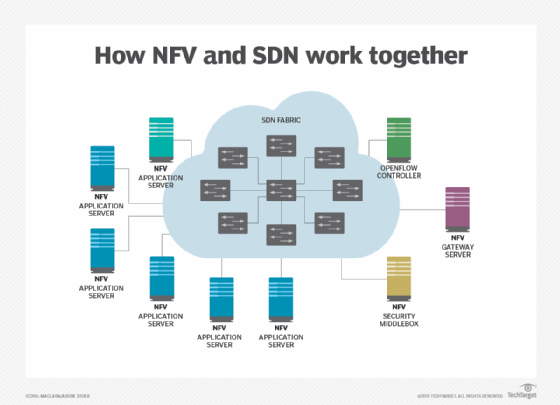NFVi (network functions virtualization infrastructure)
What is NFVi (network functions virtualization infrastructure)?
Network functions virtualization infrastructure (NFVi) is all the physical and virtual networking, compute and storage components needed to deploy and operate NFV. It is one of three components in an NFV architecture, in addition to virtual network functions (VNFs) and NFV management and orchestration (MANO). NFVi is used primarily in telecom carrier networks and cloud service provider environments.
The European Telecommunications Standards Institute (ETSI) published the first reference architecture for NFV in 2012. The NFV framework defines a way to virtualize network services, enabling them to run on generic servers instead of proprietary hardware.
Apart from ETSI, there are open source projects also developing NFV and NFVi standards, including Open Platform for NFV, Open Source MANO and MEF -- formerly the Metro Ethernet Forum.
NFVi starts with the physical infrastructure -- commodity servers -- which use a hypervisor or container platform to create a virtualization layer that abstracts the compute, network and storage resources. These components serve as the foundation for creating VNFs, which deliver various network services (e.g., SD-WAN and firewall) as purely software-based services on one open platform.
NFVi can span multiple locations, in which case the network connecting those locations is also part of the overall NFVi.
NFVi is an important component of the telco cloud. This model is reshaping the telecom industry by allowing providers to introduce new services faster, deliver services on-demand, reduce capital expenses and provide higher-quality user experiences.

Network functions virtualization architecture
ETSI defined the standards for NFVi implementation and describes the NFV architecture, the latter of which consists of three main elements.
VNFs
A VNF is a network service -- such as file sharing, network address translation, WAN optimization or IP configuration -- that runs as a virtual machine (VM) or container on a commodity server, as opposed to standalone hardware for each function. Previously, running these applications would require proprietary, dedicated hardware. Different VNFs can be executed in a specific sequence, a process known as service chaining, using software scripts -- allowing for greater agility.
NFVi
NFVi refers to all the infrastructure components needed to run VNFs. Through the use of servers, software, hypervisors, VMs, virtual infrastructure managers and container management platforms, NFVi creates the physical and virtual layers of an NFV-based environment.
MANO
MANO provides the framework for managing and orchestrating VNFs and the NFVi. With MANO, new VNFs can be provisioned quickly, usually in just a few hours, and in an automated fashion. When integrated with APIs, NFV MANO can seamlessly work with technologies from many different vendors and across many network domains.

Advantages of NFV and NFVi
The components of the NFV framework are standardized by the ETSI to improve stability and ensure interoperability. Since NFV elements are packaged as VMs or containers on commodity hardware, service providers don't have to rely on proprietary servers. Instead, they can operate their networks on standard servers, run VNFs across different servers or even move them around as needed.
This flexibility and abstraction of network services greatly reduces capital expenses to dynamically deliver new services and applications. Providers can also deliver these services faster and on-demand to satisfy the fast-changing needs of their users.
Another advantage of NFVi is that there's no need to assign dedicated hardware for each network function. Instead, since network functions are virtualized, a single server can run multiple functions, allowing for resource consolidation and operational cost savings. In all these ways, NFVi helps to improve business scalability and agility while reducing the need for physical space and power. Additionally, NFVi standards enable multivendor environments and increase the interoperability of VNF components.
In summary, NFVi provides the following benefits to service providers and end users:
- Extensible and scalable infrastructure for faster service deployment.
- Easier network management and operation via NFV MANO platforms.
- Enhanced service availability and security.
- Greater scalability, agility and cost-effectiveness.
NFVi vs. software-defined networking
Software-defined networking (SDN) is a networking architecture in which software-based controllers are used to direct the traffic on a network and simplify network infrastructure management. In contrast, traditional networks use dedicated hardware devices to control network traffic. SDN can be used to create and control both traditional hardware and virtual networks.
Like SDN, NFV and NFVi also rely on virtualization and use network abstraction to separate network services from the underlying physical environment. However, NFV and SDN abstract resources differently. NFV abstracts network functions from hardware whereas SDN abstracts the network control plane from the packet forwarding plane (or functions).

SDN aims to create a centrally manageable network. In contrast, the aim of NFVi is to allow network services to run on standard servers so they won't require proprietary hardware. That said, SDN and NFV are complementary and can be used together. NFVi supports the use of SDN software. When combined, NFVi and SDN help to create a network that is more flexible, agile, scalable, resource-efficient and cost-effective.

See how NFV architecture works and why 5G core network functionality is driven by SDN and NFV. Explore how carrier network virtualization leads to enterprise services, 5 network virtualization challenges and how to solve them and the latest on NFV and VNFs for enterprises.



